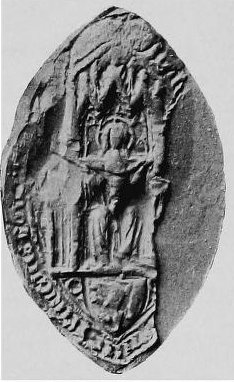Markyate Priory

One of the common seals of the Priory of Markyate
|
|
| Monastery information | |
|---|---|
| Order | Benedictine |
| Established | 1145 |
| Disestablished | 1537 |
| Site | |
| Location | Markyate, Caddington, Bedfordshire, England |
Markyate Priory was a Benedictine priory in Bedfordshire, England. It was established in 1145 and disestablished in 1537.
The priory of Markyate was founded in 1145, in a wood which was then part of the parish of Caddington, and belonged to the Dean and Chapter of St Paul's Cathedral, London. Ralf de Langford, who was dean at the time, granted the site at a rent of 3s. annually; adding to it afterwards another portion at a rent of 6s. As the house was built under the patronage of Geoffrey, sixteenth abbot of St. Alban's, and endowed by him (though not with the goodwill of his convent) with tithes from Cashio and Watford, it has sometimes been called a cell of that abbey; but this is scarcely a correct description of it, as the patronage remained always with the Dean and Chapter of St. Paul's, and the nuns were never exempt from episcopal jurisdiction. There can however be no doubt that in its early days the priory was closely connected with St. Alban's, though the history of its origin is somewhat involved in legend. It is said that a monk called Roger went out from the abbey some time during the reign of Henry I, with the consent of his abbot, to seek a place for a hermitage; and was guided to choose a spot in the woods near Caddington, not far from Watling Street. There he lived for some time in such solitude as he desired, until a damsel from Huntingdon, Christine by name, came and placed herself under his direction, believing that she had a similar vocation. He enclosed her in a shed close by his own hermitage, and fastened the door with planks in such a way that she could not open it herself, nor could she be seen by any passers-by; and in this narrow dwelling she remained for four years, enduring with heroic courage heat and cold alike, and only released from her cramped posture once a day at dusk. At the end of this time her patience was rewarded by heavenly visions, which convinced Roger that it was indeed her destiny to succeed him in his cell. When he died, and was carried to St. Alban's to be buried 'in a curved place on the south wall near the choir,' it was natural enough that the abbot should take Christine under his special protection and patronage. A woman could scarcely live quite alone in a wood away from either town or church, but it was not difficult in the twelfth century to find a few others who were willing to embrace the stricter forms of the religious life; so Christine was soon surrounded by disciples. The formation of the house into a priory under the Benedictine rule was probably due to the influence of St. Alban's.
...
Wikipedia
